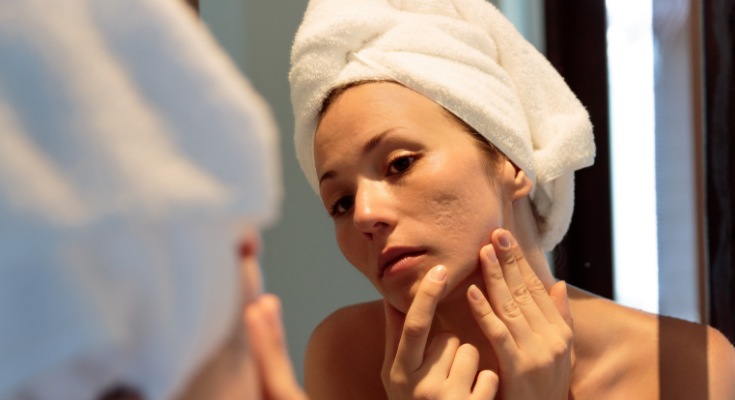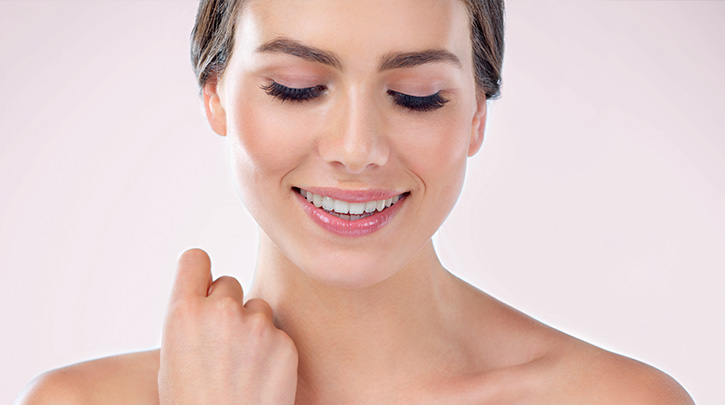




Scrapes, cuts, and wounds are a natural part of life. While scars are required in the healing process, it’s not necessary to wear these little battle wounds as badges forever. With the proper treatment, you can promote proper wound healing short-term to reduce the appearance of scarring long-term.
The formation of scars is simply the body’s natural reaction to wound healing. When injured, a signal is triggered that sets skin cell renewal into overdrive. Your body begins producing collagen at an accelerated rate to seal the wound, heal damaged skin, and promote healthy skin regeneration. During this process, a few factors can weigh in on how a scar appears, including the size, shape, and depth of a wound, blood circulation in the injured area, skin tone, and skin thickness.
The key to scar prevention is to support skin’s natural healing cycle and limit the amount of work skin needs to do to properly seal a wound and heal a scar. When treated properly, the healing cycle may be sufficiently supported to minimize the appearance of scars or eliminate scars altogether. While total scar prevention may be a long shot in some instances, the following are some steps you can take to minimize scarring during different phases of the healing process. (Note that scarring from acne will require different steps to properly treat skin and prevent scarring. In these instances, a consultation with a qualified treatment or skin care professional is recommended to ensure the proper treatments are followed based on your acne type.)
Immediately following an injury, it’s important to assess depth and severity. For injuries where cuts are deeper or gape, skin often heals better with stitches. Stitches must be sewn in (by a medical professional) immediately following injury for best results, so it’s important to seek out a medical opinion right away. Further, allowing too much time to pass may risk bacterial growth in the wound, as it’s difficult to properly clean a deeper wound on your own.
For smaller injuries, keep the wound clean to promote healthy scabbing and healing for improved scar prevention. Opt for a daily gentle cleaning with mild soap and warm water, and avoid the use (especially the overuse) of hydrogen peroxide, as it can irritate already damaged skin and further impede the healing process.
As parents often warn, don’t pick at your scabs. Scabs may be considered the body’s natural bandage that prevents further damage to vulnerable skin, keeps the site clean, and helps to minimize scarring. You may prevent a scab by frequently applying petroleum jelly to hydrate skin and keeping a dressing on the injured area. This can help to accelerate the healing process, while preventing the potential growth of a scar as it heals.
For larger burns or scrapes, including those with stitches, hydrogel or silicone gel sheets may be used in place of bandages or gauze to support skin hydration and promote accelerated healing by leveling out growth factors that help to balance collagen production and prevent scarring. Be sure to always discuss wound care with your medical provider to ensure you’re following the best course of recovery for your specific injury.
In the weeks following injury, keeping the area well hydrated is one of the most effective ways to prevent and minimize scarring. Apply petroleum jelly daily and cover with a bandage. Alternatively, the effects of silicone therapy are well documented and the gel sheets are a top pick among skin care gurus to help fade scars faster.
While efficacy of many scar treatment creams and vitamin E remain contested, massaging the area with a hydrating cream—whether that’s petroleum jelly or a lotion—can help to promote blood circulation. Improved circulation supports faster wound healing and increased skin cell renewal, minimizing your risk of long-term scarring.
The American Academy of Dermatology (AAD) also notes the importance of sunscreen use once a wound is healed to prevent further tissue damage and discoloration. According to the AAD, applying sun protection to an area where scar tissue is still healing may actually help to fade the appearance of a scar faster by preventing additional UV damage. As always, an SPF of 30 or higher is recommended and should be reapplied every two hours, regardless of whether or not you have a scar.
Finally, for injuries that require stitches, always stick to your doctor’s recommended advice for wound care and ensure you have your stitches removed within their suggested timeframe to minimize scarring.
Long-term, it’s important to practice patience and not overdo treatments in a desperate attempt to reduce scarring. Healing takes time. In fact, the first phase of the natural healing process can take about three months. Approximately a year after the initial injury, skin will start settling and scars will have essentially formed, though the appearance of the scar may continuously change over time.
Exploring your skin resurfacing options to reduce the appearance of long-term scars may help to promote reformation of new skin tissue and the gradual healing of scarring. One proven option for reducing the appearance of scars is radio frequency-based skin resurfacing treatments. Utilizing tiny pins, these treatments create little micro-dermal wounds in the skin’s surface. Through the pins, radio frequency (RF) energy is delivered deep into the dermis (the deeper layers of your skin), where it is transferred into heat energy, stimulating skin’s natural wound-healing cycle. Collagen and elastin production levels increase as a result, promoting quickened skin cell renewal. Faster, more noticeable results in scar reduction may be noted through an improvement in skin tone and texture over the duration of a complete treatment plan, with continued improvements in the weeks following your final treatment session.
Interested in learning more about the benefits of these skin resurfacing treatments in reducing the appearance of unwanted scars? Get the facts about skin resurfacing treatments or explore your customized treatment plan options by locating a certified treatment provider near you using the search field below.
Find a certified Venus Treatments provider near you today who specializes in today’s top aesthetic medical solutions.


Search below to find a provider near you and to learn about our non-surgical aesthetic treatments with ARTAS®, NeoGraft®, Venus Bliss™, Venus Versa™, Venus Legacy™, Venus Velocity™, Venus Viva™ MD, Venus Freeze Plus™, and Venus Glow™.
For more information call: +61 416 022 096 // [email protected] // Suite 3.06/ Level 3 20 Rodbourgh Road, Frenchs Forest NSW 2086, Australia
REGULATORY CLEARANCES [ More ]
Venus Versa™ has CE Mark as a multi-application device intended to be used in aesthetic and cosmetic procedures. The SR515 and SR580 applicators have CE Mark for the treatment of benign pigmented epidermal and cutaneous lesions and treatment of benign cutaneous vascular lesions. The HR650/HR650XL and HR690/HR690XL applicators have CE Mark for the removal of unwanted hair and to effect stable long-term or permanent hair reduction for Fitzpatrick skin types I-IV. The AC Dual applicator has CE Mark for the treatment of acne vulgaris. The DiamondPolar™ applicator has CE Mark for non-invasive treatment of moderate to severe facial wrinkles and rhytides on females with Fitzpatrick skin types I-IV. The OctiPolar™ applicator on the Venus Versa™ system has CE Mark for temporary body contouring via skin tightening, circumferential reduction, and cellulite reduction. The NanoFractional RF™ (Viva) applicator has CE Mark for dermatological procedures requiring ablation and resurfacing of the skin.
NeoGraft® 2.0 has CE Mark and TGA with indication for use in suction-assisted follicular extraction and re-implantation for males and females.
The ARTAS iX™ from Restoration Robotics® is indicated for harvesting hair follicles from the scalp in men diagnosed with androgenic alopecia (male pattern hair loss) who have black or brown straight hair. The ARTAS iX™ from Restoration Robotics® is intended to assist physicians in identifying and extracting hair follicular units from the scalp during hair transplantation; creating recipient sites; and implanting harvested hair follicles.
Venus Epileve™ has CE Mark for hair removal, permanent hair reduction (defined as the long-term stable reduction in the number of hairs re-growing when measured at 6, 9 and 12 months after the completion of a treatment regimen), and the treatment of pseudofolliculitis barbae for all Fitzpatrick skin types. Venus Epileve™ is also CE-Marked for hirsutism.
Venus Legacy™ has CE Mark for the temporary increase of skin tightening, circumferential reduction, cellulite reduction, and wrinkle reduction.
Venus Velocity™ has CE Mark for hair removal, permanent hair reduction (defined as the long-term stable reduction in the number of hairs re-growing when measured at 6, 9 and 12 months after the completion of a treatment regimen), and the treatment of pseudofolliculitis barbae for all Fitzpatrick skin types.
Venus Viva™ has CE Mark for the use in dermatologic and general surgical procedures requiring ablation and resurfacing of the skin, and the treatment of moderate to severe facial wrinkles and rhytides in Fitzpatrick skin types I-IV with the DiamondPolar™ applicator.
Venus Freeze Plus™ has CE Mark for treatment of moderate to severe facial wrinkles and rhytides using the DiamondPolar™ applicator, and CE Mark for the treatment of cellulite reduction, increase of skin tightening, and temporary circumferential reduction on the OctiPolar™ applicator.
Venus Freeze™ has CE Mark for treatment of moderate to severe facial wrinkles and rhytides using the DiamondPolar™ applicator, and CE Mark for the treatment of cellulite reduction, increase of skin tightening, and temporary circumferential reduction on the OctiPolar™ applicator.
Venus Glow™ provides a dermal rejuvenation treatment that works to open up and deep-clean pores. Venus Concept is the exclusive distributor for Venus Glow™.
Copyright © 2023 Venus Concept. All rights reserved.
You are entering our website. For other country/regions and language options, please click the button below.
Click HereAre you a physician or aesthetician? Please visit our medical and aesthetic professional website to learn more.
Click Here